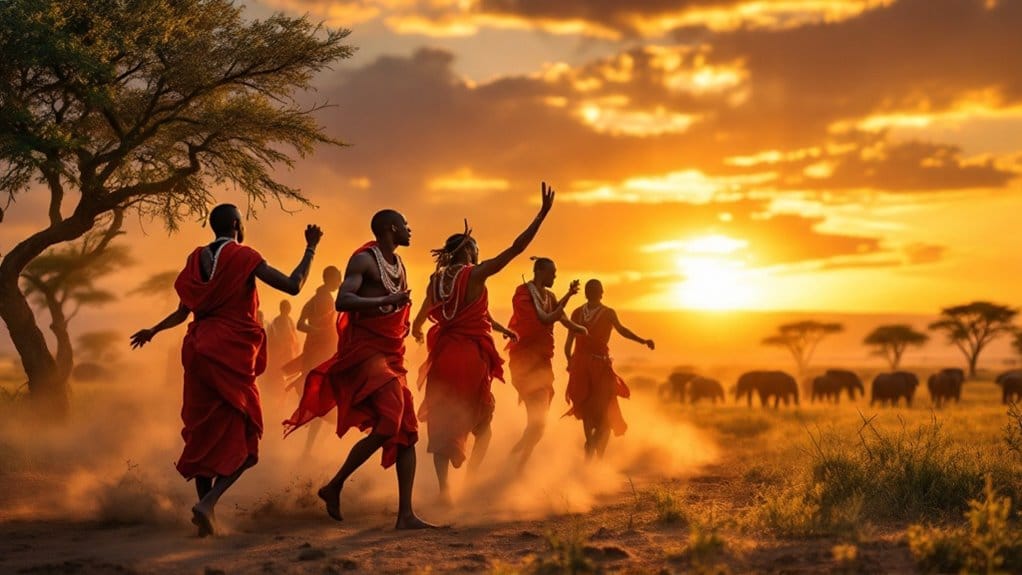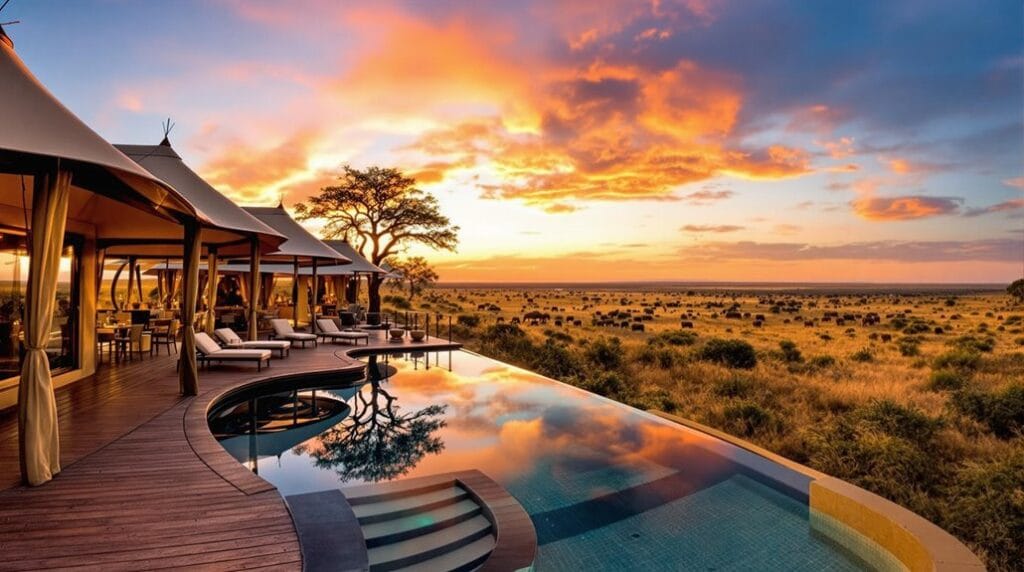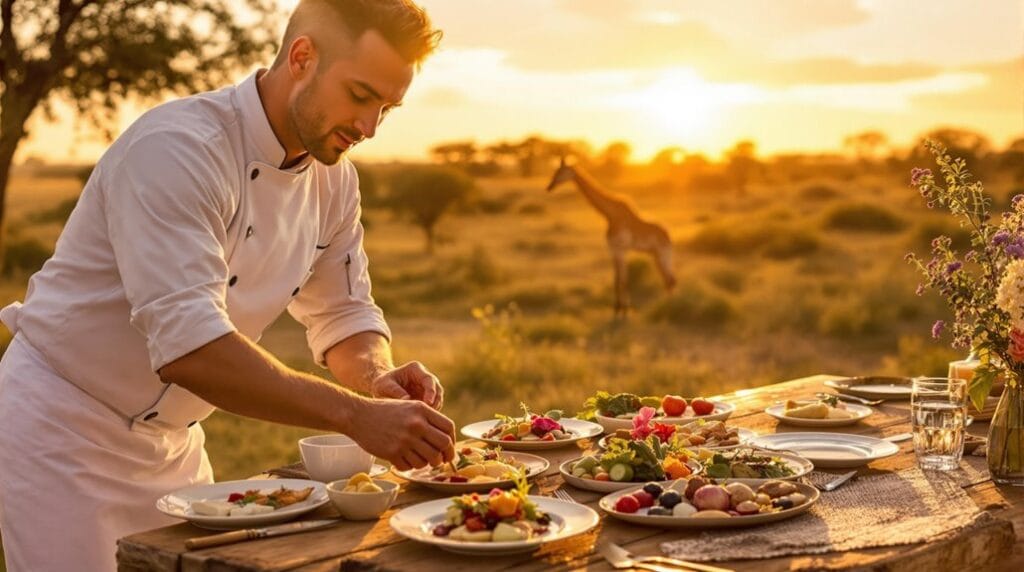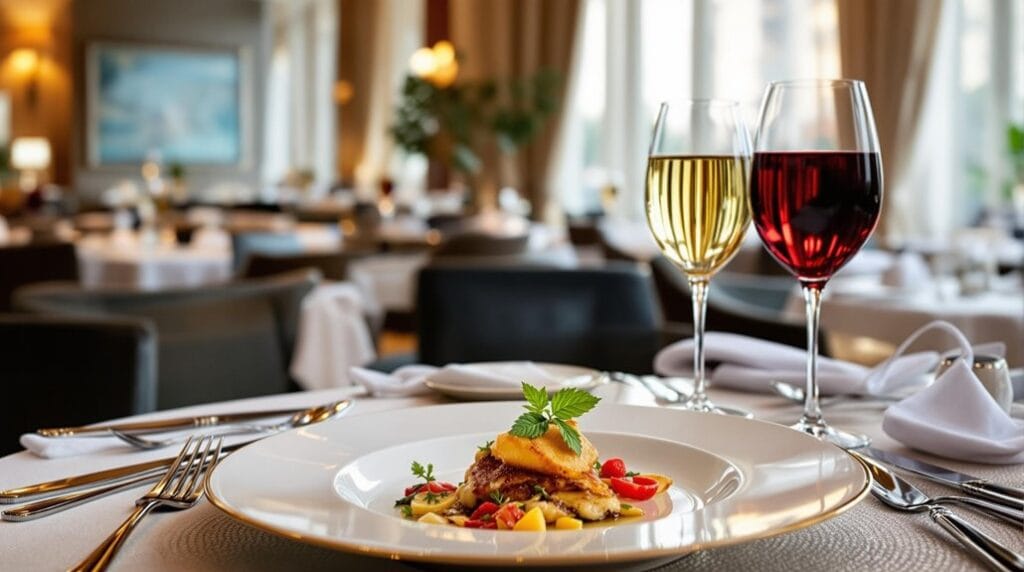Experiencing traditional African rituals like the Himba ceremonies, San Healing Dance, or Maasai jumping rituals enriches your safari adventure immensely. You'll witness the vibrant culture through colorful attire and enchanting performances. Each ritual not only celebrates community heritage but also strengthens bonds among participants, reflecting values of identity and pride. Take part in the Wodaabe's intricate courtship dance or marvel at the significance of Mursi lip plates, understanding their role in beauty and status. These immersive experiences deepen your connection with the local culture and enrich your journey, inviting you to explore more fascinating traditions and stories.
Key Takeaways
- Engaging in Himba beauty practices, like applying otjize, offers tourists a unique cultural experience and insight into local traditions.
- Participating in the Maasai Adumu jumping rituals allows visitors to witness and celebrate community strength and cultural pride.
- The San healing dance fosters unity while providing an opportunity for travelers to understand traditional healing practices and spiritual connections.
- Attending the Wodaabe Gerewol ceremony highlights the importance of beauty and courtship in local culture, enriching the safari experience.
- Cultural tourism initiatives promote sustainable interactions between travelers and local communities, enhancing economic benefits and preserving traditional practices.
The Himba of Namibia
The Himba people's vibrant culture is a reflection of their resilience and deep connection to the harsh landscapes of Namibia. Living mainly in the Kunene Region, these semi-nomadic communities adapt to seasonal rainfall while preserving their rich cultural heritage. With around 50,000 Himba, their way of life revolves around livestock, especially cattle, which symbolize wealth and social status.
When you witness traditional Himba ceremonies, you'll feel the energy of community and celebration. Events like weddings are particularly striking, showcasing elaborate attire and rituals that highlight beauty and unity.
The women's use of otjize, a mixture of butterfat and red ochre, protects their skin from the sun while enhancing their allure—a practice that embodies their identity and connection to the land.
Moreover, Himba women often choose their children's names based on unique songs, infusing personal meaning into their identities. Each name carries a story, emphasizing the deep bonds of family and community.
Engaging with the Himba offers you a unique lens through which to appreciate a culture that thrives amid adversity, inviting you to embrace their values of beauty, belonging, and resilience.
The San Healing Dance
In the heart of the Kalahari Desert, a mesmerizing spectacle unfolds as the San people gather for their Healing Dance, an ancient ritual that's both a celebration of life and a profound act of healing. This all-night ceremony, rich in tradition, integrates chanting, breathwork, and rhythmic movements designed to induce trance-like states for healing purposes.
As you witness this vibrant cultural activity, you'll feel the energy of the community, united in their efforts to support individuals facing mental and physical health challenges, including the condition known as "star sickness."
Led by skilled healers, the dance fosters a deep connection to ancestral spirits, inviting guidance and restoration.
Key aspects of the San Healing Dance include:
- Elaborate footwork that captivates and engages
- Rhythmic music that resonates with ancient traditions
- Community involvement that strengthens bonds among participants
- The transformative trance-like state that opens pathways to healing
Through this sacred ritual, the San people of South Africa reaffirm their cultural identity, showcasing the powerful role of community in maintaining mental and spiritual well-being.
You can't help but feel a sense of belonging in this vibrant tapestry of life.
Maasai Jumping Rituals
When you witness the Maasai jumping ritual, known as Adumu, you can't help but feel the energy of tradition and celebration in the air.
Young warriors, adorned in vibrant shuka, leap high into the sky, each jump not only showcasing their strength but also symbolizing cultural pride and the importance of community.
The rhythmic chanting and collective clapping from those gathered create a powerful atmosphere, reinforcing social bonds and the significance of this rite of passage.
Significance of Jumping Rituals
Celebrating strength and agility, the Maasai Jumping Ritual, or Adamu, holds profound significance within Maasai culture. As you witness this traditional dance, you'll notice that it goes beyond mere entertainment; it's a powerful rite of passage for Maasai boys, marking their transformation into manhood and readiness for marriage.
The rhythmic jumps resonate with the audience, showcasing not just physical prowess but also reinforcing deep-rooted community bonds among the Maasai people.
During the Adamu, you'll see:
- Young warriors leaping high, competing for admiration.
- Vibrant shukas worn, each color reflecting unique cultural meanings.
- A gathering of community members, celebrating togetherness.
- Potential brides observing, influenced by the display of strength.
These jumping rituals embody the essence of Maasai identity, evoking pride and connection within their society. Each leap signifies more than just athleticism; it symbolizes a young man's commitment to his culture and community.
Participating in or observing the Adamu offers you an enriching cultural experience, allowing you to feel a sense of belonging amidst the vibrant traditions of the Maasai people.
Cultural Attire and Symbolism
The vibrant shuka garments worn by the Maasai during the jumping rituals serve as a visual representation of their rich cultural heritage and societal values. Each color of the shuka carries deep meanings; for instance, red symbolizes bravery and strength, reflecting the warriors' courageous spirit.
When you witness the Adumu, or jumping dance, you're not just seeing athleticism; you're experiencing a pivotal traditional ritual where young Maasai men leap high into the air, demonstrating their readiness for marriage and societal responsibilities.
As they jump, the communal energy is palpable, enhanced by the practice of spitting, which conveys blessings and good wishes, reinforcing communal bonds. The dance becomes a canvas for cultural expression, fostering pride among the Maasai.
It's about more than just the performance; it's about identity and belonging. Each leap is a proof of their heritage, a celebration that combines artistry with profound meaning.
Participating in or observing this ritual allows you to connect with the Maasai's vibrant culture, appreciating the intricate relationship between their attire and the spiritual significance of their traditional rituals.
This experience enriches your understanding of what it means to be part of a community anchored in rich traditions.
Community Involvement and Celebration
Amidst the rhythmic beats of traditional drums, the Maasai Jumping Ritual, or Adamu, unfolds as a profound expression of community involvement and celebration. This vibrant event not only marks the initiation of young warriors but also reinforces the Maasai's cultural identity and social values.
As you watch, the colorful shuka garments worn by participants symbolize various cultural meanings, enhancing the visual splendor of the ritual.
During the Adamu, the atmosphere buzzes with energy and anticipation. The community gathers, showcasing their collective spirit through:
- Impressive displays of strength and agility
- The ritualistic spitting, symbolizing blessings and shared energy
- The rhythm of drums uniting everyone in a shared experience
- Local guides narrating the stories behind each jump, deepening your understanding
Each jump not only highlights a warrior's fitness but also elevates their social standing, attracting admiration and potential brides.
You can feel the deep communal bonds that strengthen through the ritual, making it a true celebration of life, identity, and belonging in Maasai society. Engaging with this tradition offers you a unique glimpse into the heart of a vibrant culture, enriching your safari adventure.
Wodaabe Courtship Traditions
Often, the Wodaabe tribe captivates onlookers with their stunning gerewol courtship ceremony, a vibrant and intricate ritual where young men don elaborate attire to showcase their beauty and charm.
During the Guérewol festival, these men engage in a spirited courtship dance, using exaggerated facial expressions and rhythmic movements to entice potential brides. This lively contest isn't just about competition; it reflects the Wodaabe's rich cultural identity and their deep-rooted values surrounding beauty and marriage.
As you watch, you'll notice how participants enhance their appearance with natural cosmetics and adornments, underscoring the importance of aesthetic presentation in Wodaabe culture.
This traditional ritual serves as a celebration of heritage, where the community comes together, and visitors gain insight into the tribe's social dynamics.
For those on safari adventures, witnessing the gerewol offers a unique opportunity to appreciate the Wodaabe's vibrant customs and the significance they place on love and attraction.
It's more than a dance; it's an invitation into a world where beauty, charm, and community intertwine, creating a sense of belonging that resonates across cultures.
Mursi Lip Plate Significance
Within the vibrant culture of the Mursi people in Ethiopia, lip plates stand as powerful symbols of beauty and social status, enchanting anyone who encounters them. These iconic adornments, which can measure up to 7.7 inches in diameter, aren't merely accessories but essential expressions of Mursi identity and traditions.
- Cultural roots: The practice of wearing lip plates has been ongoing for about 30,000 years, deeply embedded in Mursi heritage.
- Beauty standards: They signify pride and desirability, influencing marriage customs and perceptions of beauty within the community.
- Expressions of love: Lip plates are removed in mourning, reflecting a profound connection between love, loss, and identity.
- Cultural contrast: This practice starkly contrasts Western ideals of beauty, showcasing the rich tapestry of African traditions.
As you engage with the Mursi, you'll realize that lip plates are more than physical traits; they're living symbols of resilience and community values.
Understanding this significance allows you to connect more deeply with the Mursi people, embracing the diverse beauty found in their traditions and cultural roots.
Cultural Preservation Efforts
How can we guarantee that the rich cultural heritage of Africa thrives in the face of modernization? Cultural preservation efforts play a crucial role in this mission. By fostering sustainable interactions between travelers and local communities, these initiatives guarantee that traditional practices remain vibrant. Organizations are documenting and sharing indigenous traditions through cultural festivals, igniting awareness and appreciation for the diverse practices across various tribes.
Community involvement is key. When locals engage in cultural tourism, they take pride in their heritage, offering visitors authentic experiences that reflect their traditions. Imagine witnessing the Himba's unique otjize application or participating in the Maasai's spirited Adamu dance—these moments create lasting connections.
Educational programs enhance this exchange, emphasizing the importance of preserving cultural practices and fostering mutual respect. Integrating these rich cultural experiences into safari itineraries not only supports economic sustainability for communities but also enriches your journey through Africa.
Frequently Asked Questions
What Are African Tradition Rituals?
African traditional rituals encompass healing dances, initiation ceremonies, harvest festivals, ancestral worship, and storytelling traditions. These vibrant practices connect you to the community, enriching your understanding of identity, culture, and the spiritual bonds that unite generations.
What Is the Best Traditional Ceremony in Africa?
When you explore Africa's best cultural experiences, you'll discover unique tribal practices, vibrant festival celebrations, and sacred rites' significance through traditional dance forms, each reflecting the rich heritage and community spirit of the continent.
What Are the Cultures and Traditions of Africa?
Africa's vibrant variety enthralls you with engaging storytelling, colorful cultural attire, rhythmic tribal music, communal gatherings, and delicious traditional cuisine. Each element enriches your understanding, connecting you deeply to the continent's diverse heritage and shared spirit.
Conclusion
As you commence your safari adventure, don't just seek the stunning sights of wildlife; immerse yourself in the rich rhythms of traditional rituals. Each encounter, from the Himba's vibrant colors to the Maasai's majestic jumps, offers a tapestry of tales that deepen your experience. By embracing these extraordinary expressions, you not only enrich your journey but also contribute to the cultural continuity that keeps these enchanting customs alive for generations to come.








